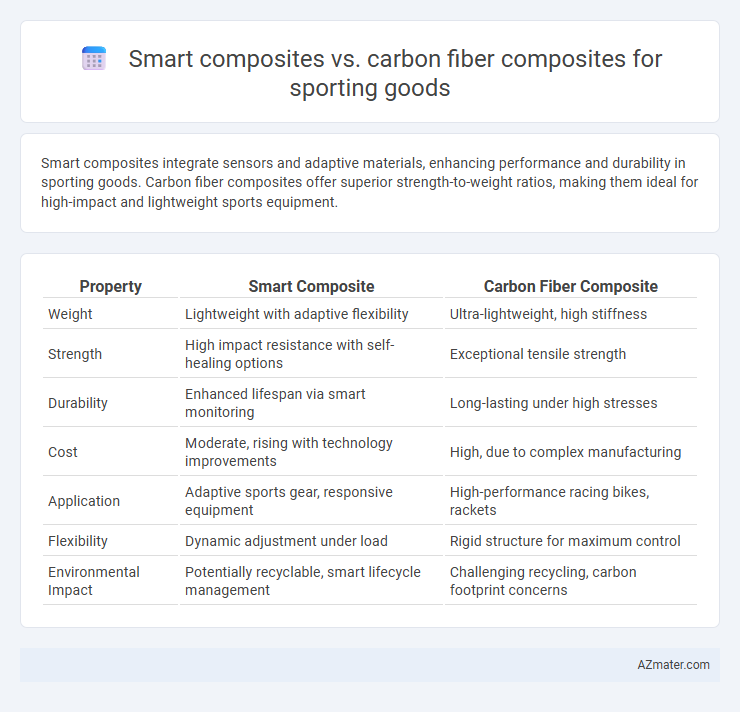Smart composites integrate sensors and adaptive materials, enhancing performance and durability in sporting goods. Carbon fiber composites offer superior strength-to-weight ratios, making them ideal for high-impact and lightweight sports equipment.
Table of Comparison
| Property | Smart Composite | Carbon Fiber Composite |
|---|---|---|
| Weight | Lightweight with adaptive flexibility | Ultra-lightweight, high stiffness |
| Strength | High impact resistance with self-healing options | Exceptional tensile strength |
| Durability | Enhanced lifespan via smart monitoring | Long-lasting under high stresses |
| Cost | Moderate, rising with technology improvements | High, due to complex manufacturing |
| Application | Adaptive sports gear, responsive equipment | High-performance racing bikes, rackets |
| Flexibility | Dynamic adjustment under load | Rigid structure for maximum control |
| Environmental Impact | Potentially recyclable, smart lifecycle management | Challenging recycling, carbon footprint concerns |
Introduction to Composite Materials in Sporting Goods
Smart composites in sporting goods integrate sensors and responsive materials to enhance performance and durability, offering real-time feedback and adaptive characteristics. Carbon fiber composites provide exceptional strength-to-weight ratios and stiffness, making them ideal for high-performance sports equipment like tennis rackets and bicycle frames. Advances in smart composites are driving innovation beyond traditional carbon fiber by combining lightweight structure with active functionality.
Overview of Carbon Fiber Composites
Carbon fiber composites are highly favored in sporting goods for their exceptional strength-to-weight ratio, stiffness, and durability, making them ideal for high-performance equipment like tennis rackets, bicycles, and golf clubs. These composites consist of carbon fibers embedded in a polymer matrix, typically epoxy, which provides enhanced mechanical properties and resistance to fatigue. Their lightweight nature and ability to be molded into complex shapes enable superior agility and precision in sports applications compared to traditional materials.
Defining Smart Composites: Features and Functions
Smart composites in sporting goods integrate sensors and adaptive materials to enhance performance monitoring and real-time responsiveness, unlike traditional carbon fiber composites known for their high strength-to-weight ratio and rigidity. These smart composites enable functionalities such as impact detection, self-healing, and stiffness modulation, providing athletes with dynamic feedback and improved safety. By combining advanced fibers with embedded electronics, smart composites represent a new generation of multifunctional materials tailored for high-performance sports equipment.
Performance Comparison: Strength and Flexibility
Smart composites in sporting goods integrate advanced materials and sensors to optimize performance by adapting to stress and impact, offering superior flexibility and strength compared to traditional carbon fiber composites. Carbon fiber composites provide high tensile strength and lightweight properties, but generally lack the dynamic adaptability and self-monitoring abilities of smart composites. This enhanced performance enables smart composites to deliver improved durability, shock absorption, and responsive flexibility, crucial for high-impact sports equipment.
Weight, Durability, and Longevity
Smart composite materials used in sporting goods often integrate sensors and adaptive components, offering enhanced durability and longevity compared to traditional carbon fiber composites. Carbon fiber composites, prized for their lightweight nature, deliver exceptional strength-to-weight ratios, making them ideal for performance-critical applications where weight reduction is paramount. While carbon fiber excels in weight savings, smart composites provide added functionality and improved resistance to wear and fatigue, extending the lifespan of sporting equipment.
Integration of Technology in Smart Composites
Smart composites in sporting goods incorporate embedded sensors, microprocessor controls, and adaptive materials that enhance performance monitoring and real-time feedback, surpassing traditional carbon fiber composites in interactive functionality. Carbon fiber composites provide exceptional strength-to-weight ratio and rigidity ideal for high-performance sports equipment but lack the integrated technological systems present in smart composites. The seamless integration of IoT devices and data analytics in smart composites enables athletes to optimize training and equipment use through precise biomechanical data collection.
Cost Analysis: Production and End-User Pricing
Smart composites often integrate intelligent materials and sensors, resulting in higher production costs compared to traditional carbon fiber composites, which benefit from established manufacturing techniques and economies of scale. Carbon fiber composites maintain a competitive edge with lower end-user pricing, making them more accessible for mass-market sporting goods, while smart composites target premium segments where enhanced performance justifies the price premium. The cost gap is influenced by factors such as raw material expenses, fabrication complexity, and the incorporation of embedded technologies in smart composites.
Applications in Popular Sports Equipment
Smart composites integrate sensors and responsive materials for enhanced performance monitoring in sporting goods, making them ideal for advanced applications like smart tennis racquets and responsive running shoes. Carbon fiber composites offer exceptional strength-to-weight ratios and stiffness, widely used in high-performance bicycles, golf clubs, and hockey sticks for improved durability and power transfer. The combination of these materials enables cutting-edge sports equipment that enhances athlete performance through lightweight design and real-time feedback.
Sustainability and Environmental Impact
Smart composites in sporting goods often incorporate recyclable thermoplastic matrices, enhancing sustainability by enabling easier material recovery compared to traditional carbon fiber composites, which typically use non-recyclable thermoset resins. Carbon fiber composites offer superior strength-to-weight ratios but pose significant environmental challenges due to energy-intensive production processes and end-of-life disposal issues. Advances in bio-based resins and fiber recycling technologies are gradually improving the environmental footprint of both materials, with smart composites currently leading in eco-friendly innovation for high-performance sports equipment.
Future Trends and Innovations in Composite Materials
Smart composites integrate sensors and self-healing properties, enhancing performance monitoring and durability in sporting goods, while carbon fiber composites remain favored for their exceptional strength-to-weight ratio and stiffness. Future trends emphasize the development of multifunctional composites combining lightweight carbon fibers with smart materials to enable real-time feedback and adaptive responses in equipment like bicycles, tennis rackets, and helmets. Innovations also explore bio-based resins and recyclable composites to improve sustainability without sacrificing the high mechanical performance demanded in professional sports.

Infographic: Smart composite vs Carbon fiber composite for Sporting goods
 azmater.com
azmater.com